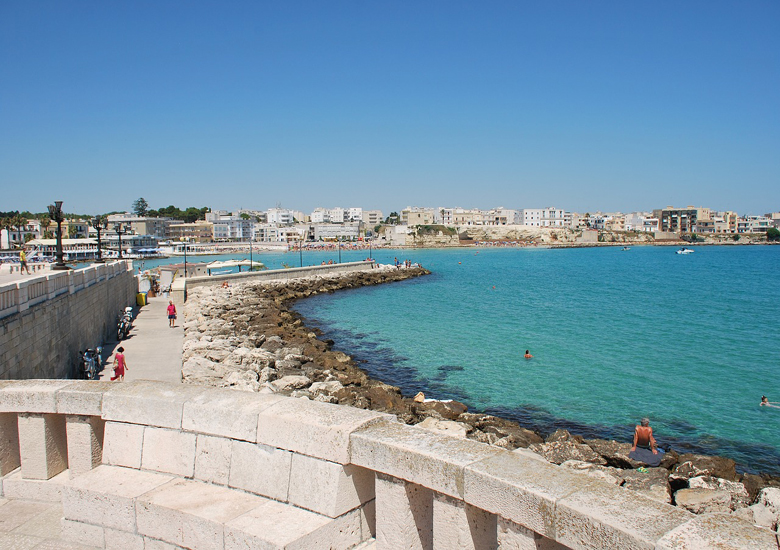Otranto is a town of about 5,700 people in the Apulia region of Italy, on the Adriatic coast of Salento peninsula. It is the easternmost town of Italy.
Understand : This small town has become a main tourist destination in Apulia, representing a true gem to discover from the medieval walls of its historic center to the fine sands of the Adriatic coast. History : The first settlement was founded by the Messapians, the native population of Salento peninsula, probably with the name of Odra. It was then rebuilt by the Greeks that renamed it as Hydrus (υδρούς – meaning “water”), becoming one of the centres of Magna Graecia. After the Roman conquest the city was called Hydruntum and became soon an important commercial port, due to its location in the easternmost point of Italy.
During the 3rd century AD Hydruntum welcomed a Jewish community that contributed to the cultural growth of the city, in which one of the most relevant libraries of Europe was built. In the 12th century this community counted about 500 families, that continued to receive protection under the rule of Emperor Frederick II, who made the town capital of the justiciarate of Terra d’Otranto (Land of Otranto), part of the Kingdom of Sicily.
In 1480 Otranto was conquered by the Ottoman troops, that beheaded about 800 civilians who refused to deny their Christian faith. The siege lasted 13 months and concluded with the liberation of the city thanks to king Ferdinand I of Naples. Otranto had been reduced to a pile of rubble and its age of splendor definitely finished, leaving to Lecce the role of cultural centre of the area.
Access : Coordinates: 40.15, 18.483333 / By plane : Brindisi Airport (BDS IATA). It is the closest airport (95 km) and provides efficient connections through buses
By train : Otranto railway station, Via Stazione, 16. The town is served by the trains of Ferrovie del Sud Est (FSE), a regional railway company that provides a link to Lecce
By car : Reaching Otranto from the airport of Brindisi requires more or less an hour. Reach the Strada Statale 16 Italia.svg freeway to bypass the center of Brindisi, then merge onto the Strada Statale 613 Italia.svg, arrived in Lecce join the Tangenziale Ovest then follow the Strada Statale 16 Italia.svg until the Adriatic sea.
Highlights :
- Old town : Aragonese Castle (Castello Aragonese), Piazza Castello. M-F 10:00-19:00, Sa Su 10:00-20:00. A majestic fortress with three cylindrical towers and impassive ramparts, deeply reinforced after the siege in 1481. You can visit the courtyard, various halls, the roof and even the dungeons. For detailed information about prices check the website.
- Cathedral (Duomo di Otranto), Piazza Basilica, Jun – Sep: 07:00-12:00,15:00-19:00. An interesting church consecrated in 1088, and built on the remains of a messapiic village, a Roman domus and an early Christian temple. It represents an interesting mixture of Byzantine and Romanesque elements, and contains an enormous mosaic pavement, relics of the Martyrs, and a crypt resembling the Mezquita of Cordoba. Free.
- Church of San Pietro (Chiesa di San Pietro), Via San Pietro (in the historic center). Jun-Sep: 10:00-12:00, 16:30-20:30 (everyday). One of the most important examples of Byzantine art in the whole southern Italy. Free.
- Monument erected to the Heroes and Martyrs, Lungomare degli Eroi. It consists in a bronze statue of a woman holding the flag and the cross, symbol of the Christianity defended till the death by almost 800 citizens, killed by the Ottoman invaders in 1480.
- Porta Terra, Via Vittorio Emanuele/Largo Porta Alfonsina. Daily. The most ancient gate to the historic center, a sober arch high about 10 m (33 ft) tall, in the western side of the medieval walls. Free.
- Porta Alfonsina, Largo Porta Alfonsina (in front of Porta Terra). Daily. The main gate of the town, between the two majestic towers “Ippolita” and “Duchessa”, dedicated to king Alfonso II of Naples, liberator of the city from Turkish invaders. Free.
- Museo Diocesano, Piazza Basilica (in front of the Cathedral), +39 0836 801133, e-mail: museodiocesano.otranto@cslpuglia.net. Here you can admire treasures from the Cathedral and other churches of the Otranto diocese: church vestments, paintings, sculptures and remains of a 4th-century AD mosaic. It’s inside Palazzo Lopez, built during the Spanish government period.
- Other sights : Bauxite quarry (Cava di bauxite), SP369, Contrada Orte (near the monument to pope John Paul II). Daily. A small lake grew into an abandoned bauxite quarry, characterised by an impressive red color of the ground, surrounded by Mediterranean scrubland. It has become a true must-see in the last years for all tourists. Free.
- Punta Palascia Lighthouse (Capo d’Otranto), Strada Provinciale 87 (under the Italian Navy base) 32 meters (105 ft) tall white cylindrical lighthouse located on the easternmost point of Italy. Walking along a path it’s possible to climb over the 2-storey keeper’s house ad admiring the wonderful view of the Adriatic Sea. It is open to guided tours for visitors, particularly at New Year, when you can see the first dawn of the New Year.
- Cave of San Giovanni. Catacombs of Torre Pinta.
Activities : Hydra boat excursions, Via del Porto, +39 389 78 07 073, e-mail: info@hydraescursioni.it. Excursions through Adriatic coast highlights such as caves, inlets and sandy beaches on Salento. Fruit and appetizers available onboard. 2 Drive along the coastline leading to Porto Badisco (road Strada Statale 87 Italia.svg) and enjoy the stunning landscape.
3 Rest in the shade of the trees.The public gardens between Via Vittorio Emanuele and the boardwalk are a good spot to rest your feet after a walk in the historic center.
Go next : Gallipoli , Lecce , Santa Maria di Leuca , Specchia

